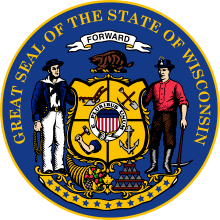Samuel Beall
| Samuel Wootton Beall | |
|---|---|
| 2nd Lieutenant Governor of Wisconsin | |
|
In office January 7, 1850 – January 5, 1852 | |
| Governor | Nelson Dewey |
| Preceded by | John E. Holmes |
| Succeeded by | Timothy Burns |
| Personal details | |
| Born |
June 16, 1807 Montgomery County, Maryland U.S. |
| Died |
September 26, 1868 (aged 61) Helena, Montana U.S. |
| Resting place | Forestvale Cemetery, Helena |
| Citizenship | American |
| Political party | Democratic |
| Spouse(s) | Elizabeth Fenimore Cooper Beall |
| Children | 7 |
| Alma mater | Union College |
| Profession |
Lawyer Land Speculator Politician |
| Military service | |
| Allegiance | United States |
| Service/branch |
United States Army Union Army |
| Rank | lieutenant colonel |
| Unit | 18th Wisconsin Infantry |
| Battles/wars |
American Civil War Battle of Shiloh |
Samuel Wootton Beall (June 16, 1807 – September 26, 1868) was an American land speculator and lawyer, who served as the second Lieutenant Governor of Wisconsin, and as an officer in the American Civil War.
Early life
Born in Montgomery County, Maryland, Beall graduated from Union College in Schenectady, New York in 1827.
Career
Beall moved to what is now Green Bay, Wisconsin in 1835, where he made a fortune in land speculation, and was admitted to the bar and practiced law. In the 1840s he settled in Taycheedah.
Between 1832 and 1856, Beall loaned the Stockbridge and Munsee Indians' delegations to Washington, D.C. some $3,000 for their expenses while they pursued claims against the federal government. He was promised one third of whatever they recovered, but when they won their case, he claimed and recovered only his actual expenditures.[1]
Beall served as a delegate to both the first and second Wisconsin Constitutional Conventions from Marquette County, one of only six men to do so (most members of the first convention declined to serve in the second).[2]
Beall was a Democrat, and served as lieutenant governor for Nelson Dewey's second term as governor, from 1850 until 1852.[3]
During the American Civil War, he was a lieutenant-colonel in the 18th Wisconsin Infantry and was wounded in the Battle of Shiloh. After recovering, he served as second-in-command of a prisoner of war camp in Elmira, New York, where the prisoners nicknamed him "old peg-leg" and accused him of a pattern of repeated cruelty and abuse.[4]
Death
After briefly returning to Wisconsin after the war, Beall moved to Helena, Montana, where, on September 26, 1868, he was shot following an argument.[5][6][7] He was re-interred in 1907 at Forestvale Cemetery in Helena.[8]
Family life
Son of Lewis and Eliza Beall, in 1829, he married Elizabeth Fenimore Cooper, a niece of James Fenimore Cooper, and they had seven children.
References
- ↑ Viola, Herman J. Diplomats in Buckskins: A History of Indian Delegations in Washington City Norman, Oklahoma: University of Oklahoma Press, 1995; p. 57
- ↑ Smith, William R. The History of Wisconsin. In Three Parts, Historical, Documentary and Descriptive. Madison: Beriah Brown, Printer, 1854. Part II. - Documentary. Vol. III; p. 302.
- ↑ "Public Square at Rapids Was First County Seat". Manitowoc Herald-Times. June 11, 1924. p. 5. Retrieved March 9, 2015 – via Newspapers.com.

- ↑ Gray, Michael P. The Business of Captivity: Elmira and Its Civil War Prison Kent, Ohio: Kent State University Press, 2001; pp. 125-126
- ↑ "Coroner's Inquest". The Montana Post. October 2, 1868. p. 3. Retrieved December 12, 2016 – via Newspapers.com.

- ↑ "Death of Co. Beall". Green Bay Weekly Gazette. October 3, 1868. p. 5. Retrieved December 12, 2016 – via Newspapers.com.

- ↑ Beall, Samuel Wooton[?] 1807 - 1868. Wisconsin Historical Society.
- ↑ "Locate Body of Former State Official". Eau Claire Leader. November 28, 1907. p. 6. Retrieved December 12, 2016 – via Newspapers.com.

External links
| Political offices | ||
|---|---|---|
| Preceded by John Edwin Holmes |
Lieutenant Governor of Wisconsin 1850–1852 |
Succeeded by Timothy Burns |
